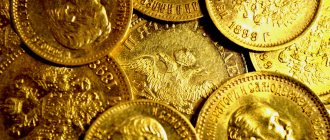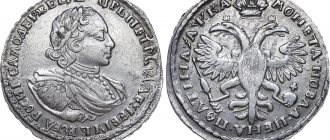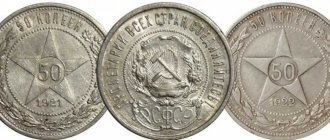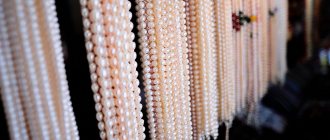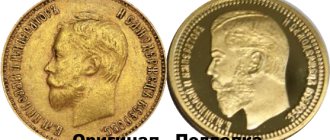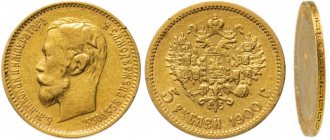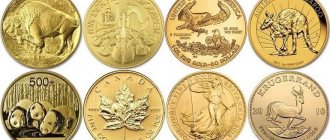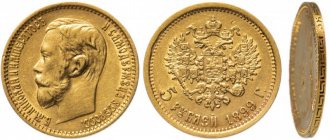For a long time in Russia, the golden chervonets had nothing to do with the denomination of 10 rubles. In the 18th century, a chervonets was a coin weighing 3.47 grams, on which there was no denomination at all. Chervonets got their name because they had a shade of red (chervon) color. Until the reign of Nicholas, the chervonets had a practically unchanged weight - 3.47 grams.
Chervonets in Rus' were called ducats, thalers and sequins - attractive gold coins. The first chervonets of Russian origin appeared under Peter I. They were similar to Dutch money, since the first Russian emperor borrowed a lot from the Dutch. They were engraved with a chest-length portrait of the king and a double-headed eagle.
Chervonets 1712
All chervonets, the denomination of which was equal to two rubles 30 kopecks, were intended for foreign trade transactions. These Peter’s coins did not circulate in Russia. A total of 36 thousand copies were produced. Of these, less than five percent have survived to this day.
How much does a golden chervonets from Peter's times cost? In 2013, a well-preserved coin from 1701 was sold at auction for 95 thousand euros. In February 2021, the Petrovsky Chervonets of the same year was sold at auction for 70 thousand euros.
Peter II in 1729 again began minting coins in high-grade gold. The value of the coins of this emperor, who died at the age of fifteen and reigned for only two and a half years, is also quite high. Chervonetsy, where Peter is depicted with a bow next to a laurel wreath, were sold at auction for 120 thousand dollars. The highest price - 170 thousand dollars - was offered for a 1729 chervonets in excellent preservation.
The chervontsev of the next empress, Anna Ioannovna, has survived to this day. Therefore, they rarely appear at auctions and are valued quite expensively. The cost of the golden chervonets, which was sold at auction in 2021, was 200 thousand dollars.
The first gold coins
The first gold coins, which were commonly called chervonets, came to us from Holland and Hungary. They were made from the purest gold with a red tint.
Then, when Ivan the Third came to power, his personal coins began to be issued, but at that time they were not recognized as money. But this royal gold chervonets was actively used as a prestigious breastplate award and table sign.
Although, already at that time, the coins of Ivan 3 had almost no differences from real gold money, because on one side there was a double-headed eagle, and on the other the sovereign. This trend was relevant before Peter 1 came to power, who later made gold chervonets money.
Witsen Collection
The Dutch scientist Nicolaas Witsen was one of the first to appreciate the high artistic and historical value of Siberian antiquities.
Arriving in 1664 as part of the Dutch embassy to Russia, he spent a year here, collecting geographical, linguistic and ethnographic information. After leaving the country, Witsen continued to correspond with Russian correspondents, collecting material for his fundamental work for 28 years - a book about Russia “Northern and Eastern Tartaria”. With the help of his agents in Russia, Witsen bought up valuable finds from ancient burials, also acquiring bronze and iron items usually thrown away by the burghers. The scientist drew attention to the discrepancy between the miserable life of the Siberian indigenous population and the widespread distribution of precious highly artistic items in these territories in ancient times: “What were those civilized people who buried these rarities like then! The decoration of gold objects is so skillful and intelligent that I doubt that it could be done better in Europe.”
In his book, the scientist also mentions a silver cup that he received as a gift from boyar F.A. Golovin. The cup went to Golovin himself when he was traveling with the embassy through Siberia to negotiate with the Chinese. At the confluence of the Irtysh and the Ob, an ancient burial was exposed in a washed-out bank, in which there were silver bracelets and a bowl. This vessel was also depicted on one of the graphic tables by the Dutch draftsman, created by order of Witsen and preserving the appearance of the rarities he collected.
Peter I's attempt to acquire the collection after Witsen's death was unsuccessful: the items were sold at auction and their further fate is unknown. However, in the 19th century. Researchers have discovered a striking similarity between some of the items depicted on Witsen’s tables and items from the collection of Peter I, transferred to the Hermitage. However, not a single complete match could be found. However, some of the objects, such as belt plates or temple pendants, appear to have been in pairs.
For example, the waist plate from the Witsen table, which depicts a wolf fighting a snake, is paired with a plate (with a similar scene) from the collection of Peter I: there is no doubt that they were found in the same mound. Judging by the letters, Witsen acquired this item in 1714. Probably, the paired plate could have fallen into the hands of Peter I at about the same time. The Russian Tsar was familiar with Witsen, who enjoyed his great respect and had an undoubted influence on him.
There is a version that a significant part of the items from Peter’s collection was a gift from the Ural factory owner Demidov to Catherine I on the occasion of the birth of the Tsarevich in 1715. It is based on the mention by I. I. Golikov in his work dedicated to Peter I of the following circumstance: “On one visit, Mr. On Demidov, a son, Tsarevich Peter Petrovich, was born to the monarch in St. Petersburg. And when noble persons, when congratulating the monarch, according to ancient custom, presented decent gifts, he, taking advantage of this opportunity, presented Her Majesty with rich golden mounded Siberian things and one hundred thousand rubles of money, a notable sum at that time.” However, the author did not even indicate Demidov’s initials; there is also no description of the donated items, which completely excludes the possibility of any identification of them.
Coins of Peter 1
Peter the first introduced many reforms; he also managed to introduce a new type of money into monetary circulation, which had many similarities with Dutch ducats. This is explained by the fact that Peter 1 preferred to study with the Dutch, as a result of which he actively used his skills.
It is worth noting that the gold first chervonets, which was issued in 118 copies, was entirely a copy of the Hungarian ducat. Its weight was 3.4 grams, it was made of gold, the purity of which reached 986. At the same time, a “double chervonets” weighing 6.94 grams was released.
The price of a coin of Peter the Great may vary depending on the year of its issue and external condition. This is a rather rare item that is often sought after by collectors. The minimum cost is $10,000, and the maximum reaches several hundred thousand.
You may be interested in: The most expensive coins of Russia and the USSR: a list of the most valuable coins
As an example, consider the royal chervonets of 1706, where the letters were minted. At the moment it is presented only in a single copy in Vienna.
Although, some data suggests that several collectors have in their inventory the presented coin, the price of which reaches $300,000.
During the reign of Peter, a gold chervonets cost only 2.30 rubles. Issued in the period 1701-1716. At that time, residents could not appreciate such an innovation, arguing that it was not easy to use, because at that time two rubles was a large amount of money.
In this regard, the presented coins were replaced with another 2 rubles, which did not have such a high standard of gold.
Gold monetary units, the denomination of which reached 10 rubles, began to be issued a little later.
Peter 2 and Elizaveta Petrovna
In 1729, Peter the Second launched the production of high-grade gold coins. How much does the royal presented chervonets cost? At the moment its price reaches $20,000. During the reign of Elizaveta Petrovna, these monetary units began to indicate the exact and complete date of production, including the month and date. If you classify them by image, then such coins are divided into two types:
- Chervontsy, which depicted St. Andrew the First-Called.
- Chervontsy, which depicted a double-headed eagle.
They were produced on the territory of St. Petersburg, the denomination was equal to five and ten rubles. Beginning in 1768, Elizabeth launched the secret production of Dutch ducats, which served as a necessary measure for foreign trade.
Ekaterina 2
During the reign of Catherine 2, the production of chervonets continued from 1762 to 1796. They were produced in St. Petersburg. In 1763, almost 50,000 copies were made, in 1766 - 28,333 pieces, and in 1796 the number reached almost 40,000 copies. The weight reached 3.47g.
An interesting fact is that the presented coins were made exclusively for trade relations with foreigners, that is, they did not have a Russian denomination.
And the cost of a gold chervonets directly depended on the price of the gold from which it was made.
You may be interested in: How much did a golden chervonets cost during the reign of Nicholas II?
All presented monetary units before the reign of Nicholas II had a specific weight and fineness.
It is worth noting that the coins that began to be issued from the reign of Peter were made portrait coins, that is, they always had an image of the royal personality. Catherine 2 divided the coins into several of her own images:
- In 1763 with a scarf.
- In 1766, without a scarf.
- And in 1796, Catherine with a heavy chin and a small neck began to be depicted on gold chervonets.
If you carefully examine these images, you will notice how much her portrait has changed. Today, the cost of the presented gold chervonets reaches tens of thousands of dollars, and the minimum price starts at $7,000.
Chervontsi of the emperors of the 18th century
The Empress's royal chervonets can be divided into two types. The first includes coins with the image of St. Andrew the First-Called, the second - with the image of a double-headed eagle, the coat of arms of the Russian Empire. Beginning in 1762, the minting of gold coins was entirely concentrated in St. Petersburg. Sometimes chervonets of double value were issued.
Elizabeth began to indicate the month of issue and the place of minting. During her reign, many gold coins of various denominations were issued. During the reign of the Empress, chervonets were minted in decent quantities. For example, the largest in 1757 was 120,680 pieces. In other years of the reign, fewer chervonets were minted, from four to 20 thousand.
Chervonets during the reign of Elizabeth, despite the large circulation, have a high cost. For example, a chervonets of 1751 was purchased for 85 thousand dollars.
Catherine's chervonets were minted from 1762 to 1796 in small editions in St. Petersburg:
1763 - 50 thousand copies;
1766 - 28,344 copies;
1796 - 39,981 copies.
The stamp has changed several times. Using coins from different years, you can trace how the empress changed. On coins from 1796 she appears with a double chin and signs of age. Most likely, the empress was not embarrassed by such portraits.
Pavel became the penultimate Russian emperor under whom chervonets were issued. This coin had a significant difference from others. Paul extremely disliked his own appearance (this opinion was shared by all the emperor’s close associates), so with the greatest command he forbade the minting of his image on money.
On one side of Pavlov’s chervonets there was an inscription: “Not for us, not for us, but in your name.” On the opposite side there was a cross or a double-headed eagle. Little chervonets were minted; they were soon replaced by coins indicating the denomination. The cost of Pavlovsk chervonets at auctions starts from ten thousand dollars.
After Paul I, chervonets were not minted by any of the autocrats except Nicholas II. In numismatic catalogs it is not customary to call ten-ruble coins of Alexander I or Alexander II chervonets. True, under Alexander II, gold coins of three-ruble denominations of 917 standard and weighing 3.93 g were called chervonets.
Pavel 1
If we remember, we can say that the appearance of Paul the First was far from beautiful. This was the first reason why he stopped issuing coins with the image of rulers. Now the coins acquired other images: on one side there was the signature “not for us, not for us, but for your name,” and on the other side they painted either a cross or a double-headed eagle.
Its monetary units had no dignity, as a result of which they were quickly abandoned and they began to issue other gold chervonets, the denomination of which reached 5 and 10 rubles. Despite this, coins of Paul the First were made from 986 standard gold, and a little later from 917 standard gold. How much can the presented product cost? At auctions, the price varies from $10 to $100,000.
Nikolay 2
Nicholas II is the last emperor of Russia, who during his period in power was able to issue several variations of coins, these also include numismatic incidents. During his time, the “Rus” were created, which planned to replace the regular ruble.
You may be interested in: Where can I donate old coins and accumulated change?
Nicholas II was quite handsome, which is why he again launched the production of coins with the image of the ruler. At the beginning of his reign, full-length imperials were made, including half-imperials, which had a portrait of Nicholas 2.
How much does the Nikolaevsky Chervonets cost? Prices range from $40,000 to $50,000.
A little later, in order to replenish the royal treasury, coins whose denomination was equal to 10 rubles were reduced in weight to 8.6 grams, and five-ruble coins to 4.3 grams. At that time, their circulation reached a huge number.
Approximately the coins of Nicholas 2 were issued in several million copies. Today, despite the excellent condition of such coins, their price is not much more than the cost of gold.
Although, there is an exception. In 1906, Nicholas II issued 10 pieces of gold coins, the denomination of which is 5 and 10 rubles. They are considered numismatic rarities, and their value reaches tens of thousands of dollars.
At the moment, “remakes” have appeared on the market, which are still not fakes. This is due to the fact that the last Nikolaev gold chervonets was issued in 1911, and at the time of the revolution, the stamps used for production disappeared.
The gold standard used for “remakes” is exactly the same as the real pieces, and the quality is guaranteed by the fact that only genuine stamps were used.
Fifteen pounds of curiosities from the "land of ancient treasures"
Prince Gagarin's parcels can be considered the earliest contribution to the Siberian collection. The first of them contained only 10 items, which, according to the archival records, were examined by the sovereign and transferred to Moshkov for storage. The second parcel, sent from Tobolsk, already included 122 items - nothing more significant in terms of the composition of things had been received either before or since from Siberia. The parcel was delivered to St. Petersburg in the absence of Peter I, so P.I. Moshkov accepted the items. In an accompanying letter, Gagarin wrote to the Tsar: “Most Gracious Sovereign, Your Majesty commands me to look for old things that are found in the land of ancient luggage. And according to Your Majesty’s command, as many as I could find these golden things, I have now sent to Your Majesty with this letter. And about the power, sir, their and what things and what kind of vagas, that, great sovereign, knowledge is enclosed with this letter. Your Majesty's last slave is Matvey Gagarin. From Tobolsk, December 1716, day 12.”
Attached to the letter was an inventory indicating the weight of the items, which made it possible to identify the sent items with items from the Hermitage collection. The last thing in the inventory was “twenty small gold items sent to the great sovereign Tsarevich Peter Petrovich, which were found with the same things mentioned above.” These twenty items, addressed to the young heir, have not yet been identified in the existing collection, but it was they who apparently provided the basis for the version of the “gift of Demidov.”
Another document, dated October 1717, mentions the shipment of a third batch of Siberian finds, including 60 gold and 2 silver items. However, it is difficult to identify these things due to confusion in archival papers. In this sense, another document of the Tyumen Voivode’s Office, stored in the state archive of the Tyumen region in Tobolsk, is of great interest, which testifies to the search for gold and silver “grave things” found and sold by the “Tatars”, carried out by Prince Gagarin in execution of “his royal majesty” decree The document indicated the weight of the wanted items - 15 pounds, which coincides with the weight of the jewelry from Gagarin's third parcel. Perhaps it consisted precisely of those very sought-after “lumpy” finds.
